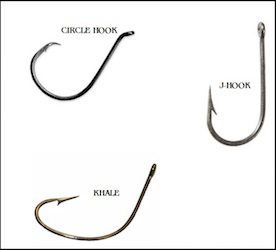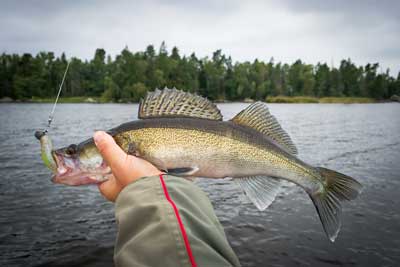Fishing Tackle – Hooks

The best piece of advice we can offer on hooks is that you fish with sharp hooks! Sharp hooks catch fish much better than dull ones!
There’s so many to choose from. We’ve listed here some of the things you should know when choosing which hook to use, and when, including offset hooks, patterns, types, construction, alloys are listed below.
And you’ll find more specific information on our species pages.
Offset fishing hooks
- A hook’s point can be offset to improve the chances of landing a fish by striking flesh or bone.
- The offset bend is bent to the side and oriented at an angle to the shank.
- Half of the offset is oriented to one side, though it makes no difference which side the hook is oriented.
- Most believe that offset hooks work best on fast biting fish.
- When using baits that don’t require the hook to be embedded deeply, the offset tends to rotate so the tip is aimed at the bait and that makes it difficult to set the hook.
- Offset hooks also tend to rotate and spin.
When not to use offset hooks
We don’t recommend offset hooks with leadhead jigs, spinners, flies, streamers, Texas-rigged plastic worms, single hook lures. With the extra effort in setting the hook, there’s other ways to gain the advantage.
Fish hook patterns
-
- Sproat: it has an asymmetrically parabolic bend and is one of the strongest patterns made and we recommend this as your primary freshwater hook pattern.
- O’Shaughnessy hook: This has to be the best hook for saltwater anglers, though it works well in fresh water as well and is often forged for extra strength. We recommend this fish hook for heavy-mouthed and slow biting fish.
- Eagle Claw: This is a common pattern used on the west coast for trolling, casting, bait-fishing and still fishing.
- Kirby: Is popular among commercial fishing with the above hooks being a better choice.
- Carlisle: this is used most often in long shanked styles when bait fishing in freshwater.
- Limerick: the Limerick doesn’t offer a strong pattern, but it’s not weak either. We recommend this hook type for fly fishing
Anatomy of a fish hook
Eye
There’s a lot of different eyes with the ball eye being the most popular. Strength is not an issue with eyes as they are considerably stronger than other parts of the hook.
Eyeless hooks are designed for lure companies that have their own way of fixing the hook to the lure.
 Hook size
Hook size
There doesn’t appear to be any standard when it comes to a hook size.
The size of a hook is generally a measure of it’s gap. Although the assigned number is not based on any form of measurement or standard. A 7/0 hook from one manufacturer won’t often match up with another.
Generally, the larger the hook, the smaller the hook number. When size one is reached, hooks are numbered 1/0, 2/0 and so on.
What matters most is the system.
What is…
- the strength of the line?
- the rods ability?
- the reel?
- the type of fish?
- the fish habitat?
- the bait used?
The hook size should be matched with all of these.
Metal Alloy
Hooks are made from metal wire. Common alloys include Inconel, Duranickel, M-Nickel and Z0Nickel to name a few. Nickel alloy hooks are common or favored with salt-water fishing as they are immune to corrosion.
The biggest disadvantage for these alloy hooks is their cost with a lesser known disadvantage being the weight.
Stainless steel hooks are as strong as the carbon-steel hooks and easier to come by then Nickel alloy hooks.
![]() Tip: Watch out for price as the cheaper ones are often made from poor steel.
Tip: Watch out for price as the cheaper ones are often made from poor steel.
Good hook makers use good steel alloys. We recommend the following hooks: Mustad, Wright and MCGill, Tru-turn, Wilson-Allen and Sealey to name a few.
Q. Why use gold plated hooks if they don’t protect the hook? I thought gold was a weak substance and very soft.
A. Gold is used to plate hooks because it’s believed to attract fish due to its shine. Gold plating is not used as a means to prevent corrosion, and is best used in fresh water. If used in saltwater, the underlying hook must be protected by nickel, stainless steel or some other alloy.
Temper
Here’s the endless debate over is it too strong or is it too weak. Weak tempered hooks will bend and lose form while strong hooks will eventually break.
Most imported cheap hooks are over tempered and should be avoided.
Wire Size
The tensile strength of the wire used to make a hook is measured in pounds per square inch and measured against the cross section. Not all hooks of a 2/0 size have the same strength.
Here we need to pay attention to the wire size categories of light, fine, thin, heavy, strong and stout. Before deciding on the wire size, know the fish you are after.
For crappie, use of a strong hook will tear a larger hole in the fish’s mouth and allow it to escape. On the flip side, using thin wire hooks for heavy or large fish won’t work as their mouths are too strong.
As always, it’s about balance.
 Bend and Pattern
Bend and Pattern
The bend is the curved part of the hook. The shape of the bend governs the hooks’ strength and penetration ability.
Sharp angles in the bend weaken the hook though a round bend has a tendency to open up. The balance comes from a bend that compromises the rounded hook and the sharp angle.
Forging
Forged hooks provide extra strength along a single plane. Forging is the process of stamping the hook and making one side thicker, resulting in the other being thinner.
Forged hooks are popular in large game fish and offshore fishing and less common for freshwater fish.
Plating
Hooks are polished with an abrasive for cleaning. Some makers use electrolysis to fill in the pits and prevent it from corroding, which also adds strength. However this greatly increases the cost.
Bite and Gap
The bite is the distance from the bottom of the bend to the tip of the point as measure parallel to the shank.
The gap on the other hand, is the distance between from the shank to the tip of the point, which is measured at a right angle.
A deep bite is more secure than a shallow bite and a wide-gap hook is good for landing pike and muskie as it sets the hook behind the thick jawbone.
Wide gaped hooks are not very strong and should be avoided.
Shank
This is the part from the eye to the bend. There’s considerable variation in the shank design from its length to the bars that may adorn its length. Hooks that have the markings of long or short refers to the shank length. A long hook is as long as the next sized hook. A 2X hook is as long as two sizes up and so on.
Many hooks are bent for a variety of reasons. For example, from the type of bait it can hold or the ability to embed in the jaw.
However, know that these bends or kinks also weaken the hook. Compound or twisted shanks improve the hooks ability to snag the jaw as it’s pulled through the fish’s mouth. Yet again, these bends weaken the hook.
Weedless Hooks
Despite the nomenclature, the weedless hook doesn’t prevent a hook from getting caught in the weeds. It does however, dramatically improve your chances of not getting caught. Usually it has some sort of device at the top of the shank that rides over top of the barb to prevent it from embedding in the weeds.
Worm Hooks
Worm hooks can be straight and plain, straight with a baitholder barb, tipped, kinked, side stepped and so on.
Regardless of the devices or design, they’re all designed to better hold the worm on the hook in a natural way.
Double Hooks
Many see doubles as simply 2 hooks back to back. While that may be an over simplification, it is essentially true.
Some doubles are bent out of a single piece of wire while others are joined together. Double hooks improve the chances of landing a fish considerably. As a result, there’s little variety in terms of patterns and design.
Treble Hooks
Treble hooks are very similar to double with the difference being the third hook. The treble hook is often used in lures and not for general angling. Many anglers also consider the use of such a hook to be unsporting, much as using explosives.
Note: IGFA will not entertain a world record if the fish is caught with a treble hook.
Baitholders
Baitholders are artifacts on the hook that allow it to better hold on to the bait. Barbs cut into the shank are an example of this device and help hold a worm or leech onto the hook.
The downside, as there’s always a downside, is that the hook can be difficult to remove from the fish’s mouth.
The Ryder is a hook that has a second smaller hook at the top of the shank. It’s hard to find and relatively expensive.
The Ryder is just one example of a multitude of baitholders. Some like the keeper, which looks more like a torture device than anything else with it’s tri-barbed attachment at the top of the shank.
Hook Safety
First and foremost, keep your tetanus shots up to date or don’t even bother fishing. Any experienced angler will tell you that if you’ve not already nicked yourself, you will.
If you happen to snag yourself with a hook, cut the line and pull out the hook by pressing down and pulling it out with a quick yank.
- If you happen to embed the hook deeply, consult a doctor to have it removed.




